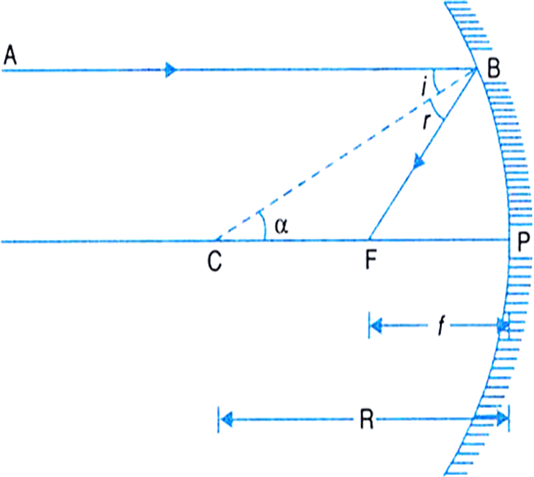Question
Deduce a relation between focal length (f) and radius of curvature (R) for a concave mirror.
Solution
Relation between focal length and Radius of curvature for a concave mirror:
Consider a concave mirror and a ray AB which is parallel to the principal axis and incident at the point B. After reflection from the mirror, this ray passes through its focus F as per the laws of reflection. If C is the cente of curvature, then CP = R, is the radius of curvature and CB is normal to the mirror at point B.

Fig. Relation between f and R for a concave mirror.
Now, according to the law of reflection,
Angle of incidence = Angle of reflection
i.e., ∠ i = ∠ r ...(1)
In
As AB is parallel to CP, so
∠α = ∠i (Alternate angles)
∴ ∠ α = ∠ r
Thus, ∆ BCF is isosceles.
Hence, CF = FB.
If the aperture (or size) of the mirror is small, then B lies close to P, so that,
i.e.,
Thus, the principal focus of a spherical mirror lies midway between the pole and the centre of curvature.
Hence proved.
Consider a concave mirror and a ray AB which is parallel to the principal axis and incident at the point B. After reflection from the mirror, this ray passes through its focus F as per the laws of reflection. If C is the cente of curvature, then CP = R, is the radius of curvature and CB is normal to the mirror at point B.

Fig. Relation between f and R for a concave mirror.
Now, according to the law of reflection,
Angle of incidence = Angle of reflection
i.e., ∠ i = ∠ r ...(1)
In
As AB is parallel to CP, so
∠α = ∠i (Alternate angles)
∴ ∠ α = ∠ r
Thus, ∆ BCF is isosceles.
Hence, CF = FB.
If the aperture (or size) of the mirror is small, then B lies close to P, so that,
i.e.,
Thus, the principal focus of a spherical mirror lies midway between the pole and the centre of curvature.
Hence proved.





